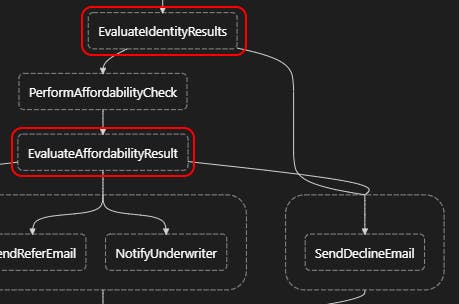Converting an AWS Step Function to use CDK - Part 2
That don't impress me much
In Part 1, we started to convert a state machine from an ASL definition used by SAM, to a fluent definition written in CDK. The full graph of the state machine is shown below:

So far, I managed, thanks to the payloadResponseOnly property, to convert the initial states that perform and aggregate identity checks.
const processApplicationStateMachine = new sfn.StateMachine(
this,
'ProcessApplicationStateMachine',
{
definition: sfn.Chain.start(
new sfn.Map(this, 'PerformIdentityChecks', {
inputPath: '$.application',
itemsPath: '$.applicants',
resultPath: '$.identityResults',
})
.iterator(
new sfnTasks.LambdaInvoke(this, 'PerformIdentityCheck', {
lambdaFunction: performIdentityCheckFunction,
payloadResponseOnly: true,
})
)
.next(
new sfnTasks.LambdaInvoke(this, 'AggregateIdentityResults', {
lambdaFunction: aggregateIdentityResultsFunction,
payloadResponseOnly: true,
inputPath: '$.identityResults',
resultPath: '$.overallIdentityResult',
})
)
),
}
);
The next step was to add a Choice state to decide whether to continue with the application or to decline it and perform the associated tasks. To start, I put in some placeholder Pass states and did a test deployment to check I had the syntax correct.
.next(
new sfn.Choice(this, 'EvaluateIdentityResults')
.when(
sfn.Condition.booleanEquals('$.overallIdentityResult', false),
new sfn.Pass(this, 'PerformDeclineTasks')
)
.otherwise(new sfn.Pass(this, 'PerformAffordabilityCheck'))
)
Now I needed to replace the PerformDeclineTasks Pass state with the real one. Looking at the original graph, the PerformDeclineTasks state needs to be referenced from two different states in the graph.

This meant that I couldn't declare the state in line with the rest of the definition, unless I wanted to duplicate the states. To be honest, the definition was getting quite unwieldy anyway, so I started refactoring and creating constants to hold the states. For example, the Map state to perform the identity checks became the following.
const performIdentityChecks = new sfn.Map(this, 'PerformIdentityChecks', {
inputPath: '$.application',
itemsPath: '$.applicants',
resultPath: '$.identityResults',
}).iterator(
new sfnTasks.LambdaInvoke(this, 'PerformIdentityCheck', {
lambdaFunction: performIdentityCheckFunction,
payloadResponseOnly: true,
})
);
In addition to creating constants for the states, we can create constants for the conditions as well. This gives us the added benefit of being able to create meaningful names for the conditions too, e.g.:
const overallIdentityResultIsFalse = sfn.Condition.booleanEquals(
'$.overallIdentityResult',
false
);
The overall result was a much more succinct definition:
const processApplicationStateMachine = new sfn.StateMachine(
this,
'ProcessApplicationStateMachine',
{
definition: sfn.Chain.start(
performIdentityChecks
.next(aggregateIdentityResults)
.next(
new sfn.Choice(this, 'EvaluateIdentityResults')
.when(overallIdentityResultIsFalse, performDeclineTasks)
.otherwise(new sfn.Pass(this, 'PerformAffordabilityCheck')) // Placeholder
)
),
}
);
One thing that caused a stumble was that the original definition for the PerformDeclineTasks state used the Parameters property for the SendDeclineEmail state to pass in a combination of static and dynamic values.
PerformDeclineTasks:
Type: Parallel
End: true
Branches:
- StartAt: SendDeclineEmail
States:
SendDeclineEmail:
Type: Task
Resource: "${SendEmailFunctionArn}"
Parameters:
emailType: Decline
application.$: "$.application"
End: true
It wasn't immediately obvious to me how to do this with CDK, as there was no Parameters property on LambdaInvokeProps. A bit of digging led me to the following AWS article: Task parameters from the state JSON
This pointed me towards the payload property and the TaskInput class. Using these I could replicate what was being achieved in the original flow, as shown below:
const performDeclineTasks = new sfn.Parallel(this, 'PerformDeclineTasks').branch(
new sfnTasks.LambdaInvoke(this, 'SendDeclineEmail', {
lambdaFunction: sendEmailFunction,
payloadResponseOnly: true,
payload: sfn.TaskInput.fromObject({
emailType: 'Decline',
'application.$': '$.application',
}),
})
);
After refactoring all states and conditions, I ended up with the following state machine definition. The full source code can be found here.
const processApplicationStateMachine = new sfn.StateMachine(
this,
'ProcessApplicationStateMachine',
{
definition: sfn.Chain.start(
performIdentityChecks
.next(aggregateIdentityResults)
.next(
new sfn.Choice(this, 'EvaluateIdentityResults')
.when(overallIdentityResultIsFalse, performDeclineTasks)
.otherwise(
performAffordabilityCheck.next(
new sfn.Choice(this, 'EvaluateAffordabilityResult')
.when(affordabilityResultIsBad, performDeclineTasks)
.when(affordabilityResultIsPoor, performReferTasks)
.otherwise(performAcceptTasks)
)
)
)
),
}
);
Here are my thoughts on the end result:
- The nesting is getting quite deep, and that is with only a couple of decisions.
- I don't find it particularly readable to my eye, despite my refactoring attempts.
- The hierarchical nature doesn't lend itself to easy editing. It is easy to cut and paste the wrong part and get lost with all the brackets.
- There is no local visualisation. I had to deploy to AWS and then use the AWS Toolkit to get the definition.
Overall, I was not as impressed as I would hoped with using this approach for step functions. The fluent syntax promised something, but didn't quite deliver for me. I use the Prettier extension for VS Code for formatting, and this syntax didn't seem to play well with it.
However, I have some ideas to help address my concerns. First up, will be a CDK Construct to generate the ASL for local visualisation.
P.S. Evaluate Expression
On this journey, I stumbled across Evaluate Expression tasks, described by the AWS documentation as follows:
Use the
EvaluateExpressionto perform simple operations referencing state paths. Theexpressionreferenced in the task will be evaluated in a Lambda function (eval()). This allows you to not have to write Lambda code for simple operations.
Armed with this knowledge I was able replace the aggregateIdentityResults Lambda function with the following:
const aggregateIdentityResults = new sfnTasks.EvaluateExpression(
this,
'AggregateIdentityResultsExpression',
{
expression: '($.identityResults).every((r) => r.success)',
resultPath: '$.overallIdentityResult',
}
);
Note the brackets around $.identityResults in the expression. Without these, the engine tries to replace a placeholder called $.identityResults.every and gets very upset indeed.

